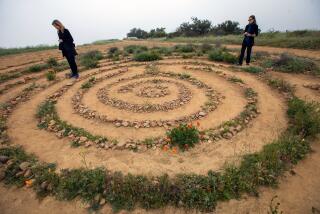Following in Footsteps of Medieval Pilgrims
- Share via
In the most literal way, visitors to the labyrinth at St. Paul’s Episcopal Church in Ventura today and Sunday can follow the same ritual that pilgrims to the famed Chartres Cathedral in France did as far back as AD 1200.
A 30- by 30-foot painted canvas replica of the limestone labyrinth in the floor of the cathedral will be on display for the public to walk on and follow both days.
“Walking the labyrinth became popular in medieval times as a substitute for a pilgrimage to Jerusalem,” said Al Campbell, who, with his wife, Marilyn, is coordinating the loan of the facsimile from Trinity Episcopal Church in Santa Barbara.
Labyrinth scholar Anne Roediger of Santa Barbara, who brought the replica to St. Paul’s, will conduct morning and evening workshops on the history and meaning of labyrinths. She will also offer suggestions on how to walk them, “although there are few rules,” she said.
The faithful once traversed the labyrinth on hands and knees, said Campbell, though it was never required. Today most walk it in bare feet or socks.
“Some call it walking prayer or walking meditation,” Roediger said.
“The labyrinth is an archetypal symbol in many religions,” she said. “That’s what originally drew me to the study of them. Something is there that has spoken to many people, traditions and cultures.
“It is not a maze to engage the mind, with choices and dead ends,” she said, since there is one path to the center and one path out. “A labyrinth helps you disengage your mind from ordinary, daily thought.”
The oldest known labyrinths date from 4000 BC on the island of Crete, Roediger said. Even today, she said, the Buddhists practice walking meditations, Hindus have something like a labyrinth called a mandala, and the Hopi Indians have medicine wheels. Britain has labyrinths of stone or earth.
San Francisco’s Grace Cathedral has a similar labyrinth woven in purple and gray into its carpet in the nave.
“Circumambulation is a part of many traditions and religions,” Roediger said. “Even the Shinto, in Japan, when they come to certain designated shrines, walk around them before going in.”
The most important thing is to walk the labyrinth at your own speed and see what comes to you, she said. “Some might say the Psalms, some might say the rosary. It’s different for everyone.”
Campbell said that when he walks the labyrinth, he is always surprised at the feelings it evokes in him.
The free self-guided walk at St. Paul’s Episcopal Church will be at the parish hall at 3290 Loma Vista Road. Adults walking at a normal pace take about 30 minutes to traverse the maze.
Roediger’s workshop for adults and teens begins at 10 a.m. today. A family workshop aimed at children will begin at 7 p.m. Call 643-5033 for more information.
More to Read
Sign up for The Wild
We’ll help you find the best places to hike, bike and run, as well as the perfect silent spots for meditation and yoga.
You may occasionally receive promotional content from the Los Angeles Times.






